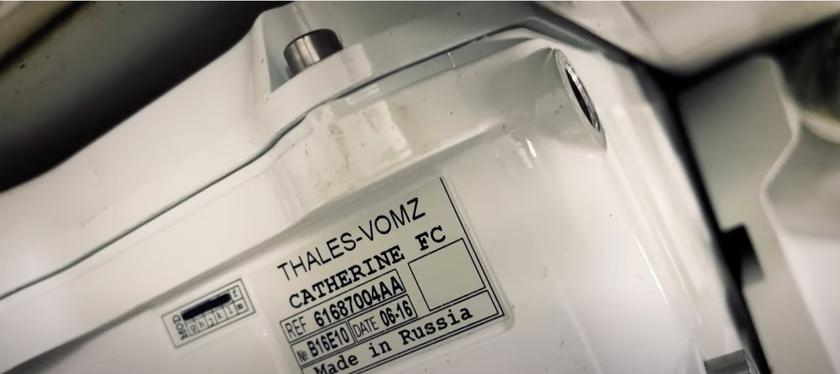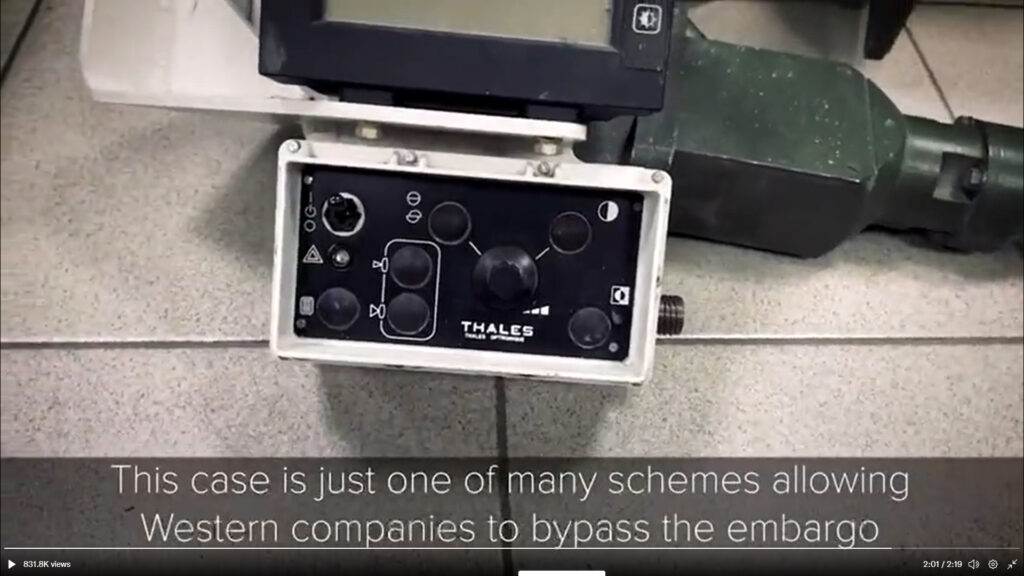
Late April it was reported that optical technology of the French/Dutch military company Thales was found in a Russian armoured vehicle near Bucha, which was captured by Ukrainian forces. The technology in the vehicle was produced in 2016 (see picture), two years after the EU imposed an arms embargo on Russia.
Thales is a mayor global military company (52 per cent military) with production and research facilities in 68 countries on all continents. It has its headquarters in Paris. A spokesman of the company denied that Thales had signed any contracts with the Russians after 2014. He made clear that no technology has been delivered after the Russian invasion of Ukraine: “any information suggesting otherwise is erroneous and therefore misleading.” The Dutch press – missing the devil in the details – reproduced this version and wrote that no exports have been made.
The war in Ukraine is not only financially profitable for military companies (see graph), it also is good for Public Relations. Helping the Ukrainians to fight the Russian invaders is considered noble and heroic. Ethical second thoughts on war profits are quickly eroding. The first Dutch military support for Ukraine in February 2022 involved several items of Dutch Thales, such as battlefield radar systems. But finding tank equipment near Bucha could cast a doubt that changing picture.
And let’s also not forget Thales still is involved in the lingering corrupion trial against the former president of South Africa. Not only South Africa, also India is mentioned as playing field for Thales bribes and irregular trade practices. So why help Thales downplay any irregular trade?

It is not the first time Thales equipment in tanks is an issue. Thales Netherlands provided the Saudi’s with the technology for battlefield communication for main battle tank and armoured vehicles, and convinced the government in The Hague it was civil technology like used in trains. Saudi Arabia tank commanders can use Thales equipment in Yemen (another countries terribly under fire of an authoritarian regime, but one without arms embargo or sanctions on its oligarchs).
In this Ukrainian case a view is given into the captured BMD-4 armoured vehicle. We see the control panel with the Thales logo, the optical device itself and the tag stating the device is produced in Russia in 2016 (see pictures). In a clip made by Ukrainians a car is shown with the 30mm holes made by a BMD mounted gun fired bullets made in a small car. We are informed that the car’s passengers were fleeing the war. And that they took their cat (there are traces of cat).
Now back to the Thales denial. The spokesperson did not say no military technology was delivered after 2014. He said no new contracts were signed. But the 2014 EU arms embargo on Russia left space for existing deals to continue. It is clear from the French arms export figures the transit of military technology to Russia only slowly came to an end as previous contracts were fullfilled.
The French Thales involvement in expanding the ability of the Russian tank optech industry is no secret and a long running project. It was a win-win situation for Paris and Moscow. Tanks for domestic use and export can be equipped with French technology. The optronic device found in Boucha is a so-called Catherine thermal image intensifier. In 2007 Catherine was exported to Russia. In May 2010 Alla Kuznetsova, the Country Director of Thales International in Russia, organised a seminar: “that brought together representatives of Thales Optronics and the Russian visor manufacturer VOMZ. Igor Sevastianov, number two at Russian armaments exporter Rosoboronexport, was among those present,” Intelligence Online reports.

In the summer of 2010, the publication continues, “under licence to Thales, VOMZ will begin manufacturing Catherine FC night vision cameras to equip Russian T90, T80, and T72 tanks and BPM-3 armoured transport vehicles [close to the bmp-4, MB] . Catherine FC, which weighs 5.5kg, can detect a tank at 10km, can classify a target at 4.5km and identify it at 2.3km.”
In 2012 Russian military industry was proud to exhibit at one of the world’s largest arms fairs, Eurosatory in France. The French product became the backbone of developments on this military technology in Russia and was further developed “in “Essa”, “Plisa” and “Sosna-U” sighting systems produced for the Russian armoured vehicles, including T-72B3 tanks and export versions of T-90S (exported to India, Algeria and Azerbaijan). And since 2012 Russia was able to produce 3rd-generation of Catherine XP cameras based on QWIP matrix technology,” an Ukrainian source revealed. Thales enabled Russia to improve its military capabilities. It is always difficult to foresee the consequences of arms sales, but clearly the damage was done. However the Catherine sage continues after that. In 2014 the Russian took the Crimea and the European Union adopted arms export sanctions on Russia. This was bad news for Thales and for Russian tank exports. The Russians were not able to mass produce the high quality thermal image intensifiers until 2016. After that an offspring product, the Sosna-U is made in Belorus and Russia,
“Joint developments between French and Russian weapon industries made Russian weapons more competitive in the market, without which Russian arms industry would slowly starve,” as a source characterised the function of the French-Russian relationship from the perspective of Moscow. For French industrialists cooperation was part of a policy to ramp up against stiffening competition in the global market. The hurdles because of the sanctions, following the Russian annexation of the Crimea, needed a solution for both.
This solution was found in the export of products to Joint Ventures created in the customer countries to have France supply directly to these third party projects rather than have these sensors assembled inside Russia, as such actions are barred by sanctions. “The Algerian-Russian joint venture to assemble T-90s in Algeria is one such example. Thales, according to some reports, has agreed to supply components for these Russian made tanks only if they are assembled in Algeria. OJSC Peleng, a Belorussian company that makes fire control systems and sensors for the Russian military, have been in close cooperation with French companies to provide components for their sensors used in Russian made tanks for export. In all, the sanctions had negligible effect for armoured vehicle sales and were nothing more than a nuisance.” France and Russia remain close.
Thales is not a complete private company. It is 26% in the hands of the French state (Thales Netherlands is also for a minor part government owned ). This “casts a shadow over the entire country, which appears to be a sponsor of terrorism that supports Russia’s military aggression against Ukraine,” a report on the find concludes. It remains an anomaly to have a military company operating on the international military market for profits, thriving by war, while depending on the budgets of governments buying weapons.
—
Martin Broek
April 2022
This text is published as Stop Wapenhandel blog on arms trade and military industry.